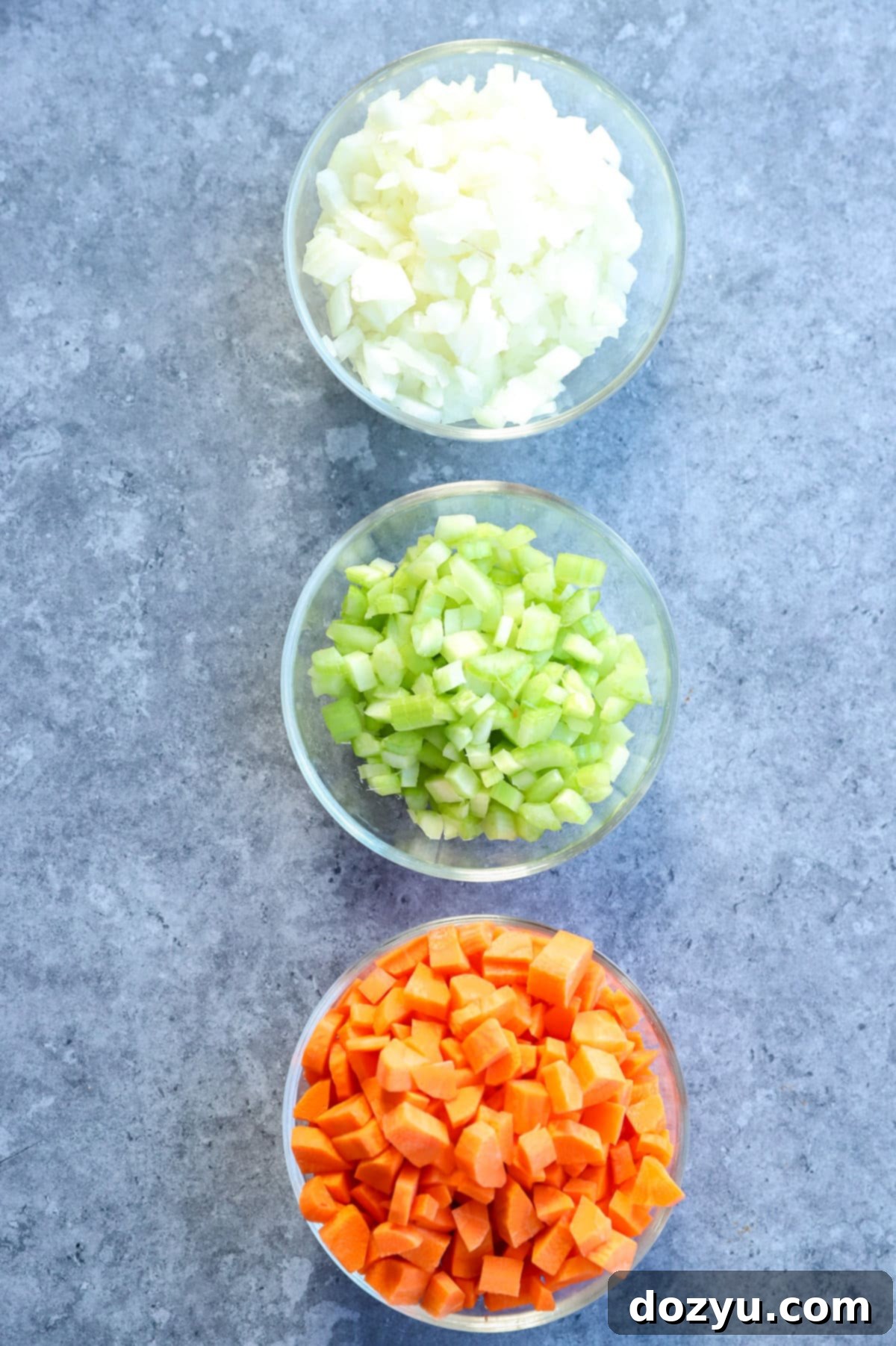Mastering Mirepoix: Your Essential Guide to This Flavorful French Vegetable Base
A cornerstone of French cuisine, a Mirepoix recipe is the aromatic foundation for countless delicious dishes. This comprehensive guide will teach you how to effortlessly create this classic combination of onions, carrots, and celery, unlocking a world of flavor for your cooking. We’ll delve into its history, explore variations, and show you practical methods for preparation, cooking, and even freezing, making meal prep a breeze for your favorite recipes!
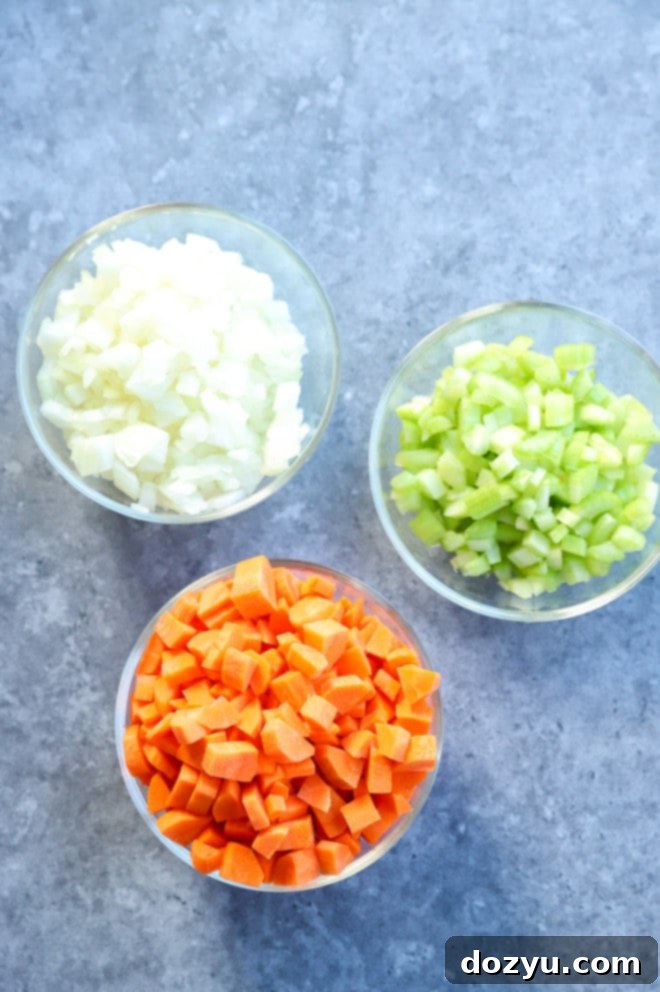
table of contents
Toggle
About This Mirepoix Recipe
Before we delve into the specifics of what makes a perfect mirepoix, let’s clarify its importance in the culinary world. While it may seem like a humble combination of vegetables, mirepoix is the secret weapon and foundational aromatic base for an astonishing array of dishes. It’s truly a game-changer for enhancing flavor, and once you master it, your cooking will reach new heights.
Many home cooks might consider purchasing pre-chopped mirepoix from the freezer aisle. However, making your own mirepoix from scratch is not only significantly more cost-effective but also delivers a fresher, more vibrant flavor profile that store-bought versions simply can’t match. The minimal effort required to chop these vegetables yourself pays off immensely in the final taste of your meal.
One of the greatest benefits of homemade mirepoix is its versatility and convenience. You can easily prepare a large batch and freeze it for later use, saving precious prep time on busy weekdays. Properly stored, frozen mirepoix can last for up to six months, making it an excellent component for efficient meal planning. Imagine whipping up a hearty soup or a rich stew in half the time because your flavorful base is already prepped and waiting! This simple step streamlines the process for many recipes, from comforting soups and robust stews to elegant braised meats and savory sauces.
We’ll explore numerous ways to incorporate this essential base into your cooking towards the end of this post, but first, let’s answer a fundamental question: what exactly is this culinary marvel?
What Exactly is Mirepoix?
If the term “mirepoix” is new to your culinary vocabulary, allow us to introduce you to a core ingredient in classical French cuisine. Pronounced meer-PWAH, it represents the aromatic soul and foundational flavor builder for an incredible number of dishes. Yet, despite its sophisticated name and profound impact, the recipe itself is remarkably simple. It consists of a harmonious blend of three readily available ingredients: onions, carrots, and celery.
The traditional ratio for mirepoix is typically two parts onion, one part carrot, and one part celery. This specific proportion is designed to create a balanced flavor profile, where the sweetness of the carrots, the earthy notes of the celery, and the pungent depth of the onions perfectly complement each other without any single ingredient overpowering the rest. When these vegetables are gently sautéed together in butter or oil, they transform. The goal is to “sweat” and soften them, allowing their natural sugars and aromatic compounds to release slowly, rather than caramelizing them. This gentle cooking process ensures a sweet, savory, and aromatic base that deepens the flavor of the entire dish without adding color or bitterness.
Once your mirepoix has been lovingly prepared, the culinary possibilities are endless! From this fragrant base, you can embark on a multitude of cooking directions. Many recipes will instruct you to add additional ingredients like a rich tomato paste, cooking it for a few minutes to develop its flavor before introducing liquids such as broth or wine, along with spices like a bay leaf or fresh herbs like thyme, rosemary, or parsley. Other variations might call for the addition of finely chopped meats, such as pancetta or bacon, which release their own fats and smoky flavors into the mirepoix, creating an even more complex and savory foundation. The specific additions depend entirely on the final dish you aim to create, making mirepoix an incredibly adaptable starting point for your culinary adventures.
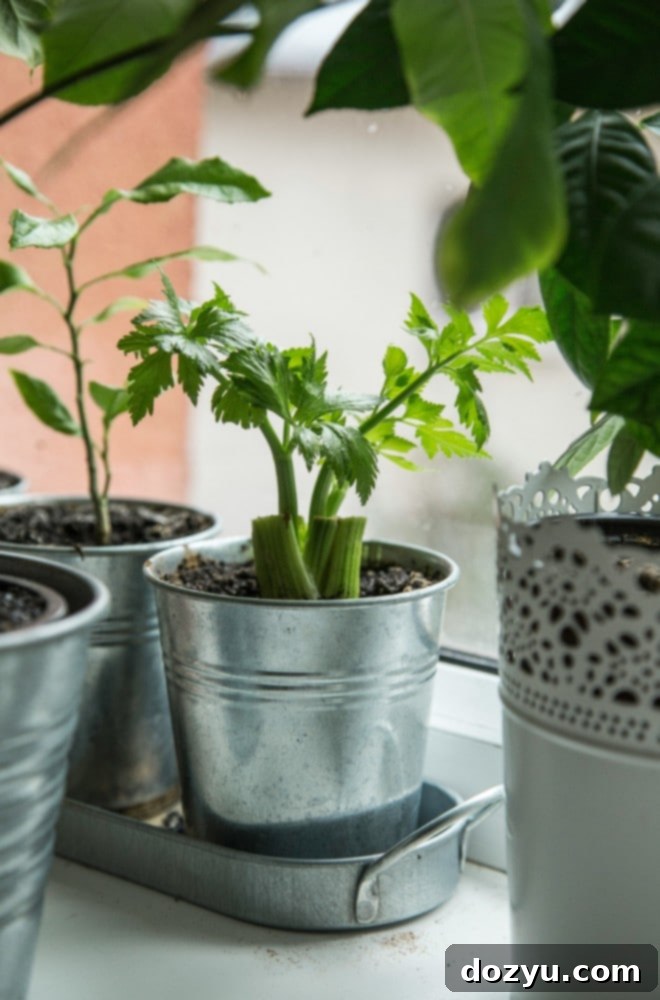
Exploring Mirepoix Variations
While the classic French mirepoix (onion, carrot, celery) is undeniably powerful, it’s just one of many beloved aromatic foundations used across global cuisines. Many cultures have developed their own “holy trinity” or “soffritto” to build flavor from the ground up, each offering a unique twist on this culinary concept. Understanding these variations can broaden your cooking horizons and allow you to infuse different cultural flavors into your dishes.
Here’s a quick guide to some popular aromatic bases beyond the traditional mirepoix:
- Mirepoix (French Cuisine): The classic trio of onion, carrot, and celery. Known for its balanced, sweet-savory depth, ideal for stocks, soups, and slow-cooked dishes.
- The Holy Trinity (Cajun Cuisine): A vibrant combination of onion, celery, and green bell pepper. This blend provides a more pungent, slightly spicy, and distinctly Southern flavor profile, essential for gumbos, jambalayas, and étouffées.
- Soffritto (Italian Cuisine): Similar to mirepoix, it features onion, carrot, and celery, often with the delightful addition of fresh parsley. Sometimes garlic is also included. Soffritto is typically cooked slowly in olive oil to achieve a deep, sweet foundation for pasta sauces, risottos, and braised meats.
- Sofrito (Latin American/Caribbean Cuisine): This aromatic base is incredibly diverse and varies by region, but commonly includes onion, garlic, bell peppers (red, green, or yellow), and tomatoes. Often, cilantro, culantro, or various herbs and spices are added. Sofrito is typically puréed or finely minced and provides a fresh, robust flavor for stews, rice dishes, and beans.
These aromatic combinations demonstrate the universal art of layering flavors, proving that a simple blend of vegetables can be the secret to extraordinary culinary results. The mirepoix, in its various forms, remains a culinary cornerstone, showcasing the artistry of flavor development.
For an added layer of complexity and a more nuanced flavor profile in your traditional mirepoix, consider incorporating a shallot alongside or in place of some of the onion. Shallots offer a milder, sweeter, and more delicate onion flavor, which can truly elevate your mirepoix and, consequently, the entire dish you’re preparing. It’s a small change that yields noticeable results, adding another dimension of flavor to explore.

Key Ingredients for a Perfect Mirepoix
Crafting a delicious mirepoix starts with selecting high-quality, fresh ingredients. Here’s a closer look at the stars of this essential aromatic base:
Onions: Traditionally, a classic French mirepoix calls for white onions, known for their sharp, clean flavor. However, don’t hesitate to experiment! Yellow onions are a fantastic, slightly sweeter alternative and are often more readily available. For an even sweeter, milder flavor, especially if you’re making a lighter dish, sweet Vidalia onions can be a delightful choice. The type of onion you choose can subtly influence the overall character of your mirepoix and the final recipe.
Carrots: Standard orange carrots are the go-to for mirepoix, providing essential sweetness and a beautiful color. When selecting carrots, look for firm, bright orange roots without soft spots. If you’re feeling adventurous or want to add a visual twist, rainbow carrots (purple, yellow, white) can be used, though their flavor might vary slightly. Ensure they are peeled and thoroughly cleaned to remove any dirt or bitterness from the skin.
Celery: Celery contributes a distinctive earthy, slightly peppery note that is crucial to mirepoix’s depth. It’s vital to clean celery thoroughly, as dirt often clings to the stalks and crevices, especially in the bunches you purchase from the grocery store. Rinse individual stalks under cold running water, scrubbing gently with a vegetable brush if necessary, and pay attention to the inner ribs where dirt can hide.
Butter or Oil: The fat you choose for sautéing your mirepoix plays a significant role in developing its flavor. Unsalted butter provides a rich, creamy base that enhances the sweetness of the vegetables and adds a luxurious mouthfeel. If you prefer, or if you need a dairy-free option, your favorite cooking oil works perfectly. Excellent choices include olive oil (extra-virgin for a more pronounced flavor, or a lighter variety for a subtle touch), canola oil, or even avocado oil. The key is to use enough fat to gently coat and cook the vegetables without frying them.
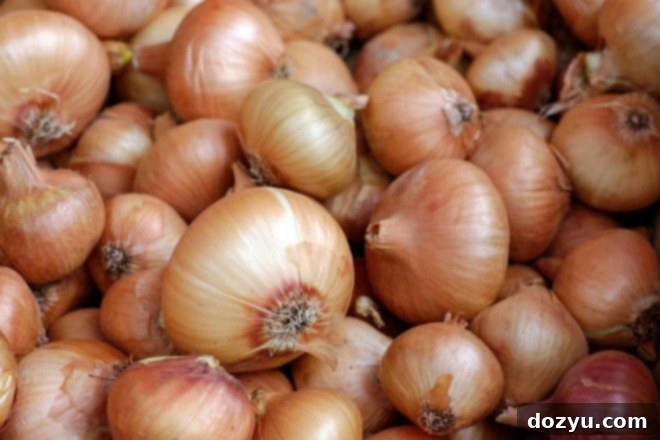
Essential Equipment for Mirepoix
While mirepoix is a simple recipe, having the right tools makes the process much smoother and more enjoyable. Here are the essential pieces of equipment you’ll need:
First and foremost, a high-quality chef’s knife and a sturdy cutting board are indispensable. Precision in chopping is crucial for even cooking, and a sharp knife makes quick work of preparing the vegetables safely and efficiently. Investing in a good knife will not only make this recipe easier but will improve all your kitchen tasks.
To cook your mirepoix, you will need either a large skillet or a sizable pot, such as a Dutch oven. The choice often depends on the subsequent steps of your recipe. If you plan to build a sauce or stew directly in the same pot, using a Dutch oven can be ideal due to its heat retention and capacity. If you’re simply prepping the mirepoix to add to another dish, a large skillet will suffice. Ensure the pan is large enough to avoid overcrowding the vegetables, which is key for proper cooking. Using the same pan you intend to use for the rest of your recipe minimizes cleanup and maximizes flavor development as you build your dish.
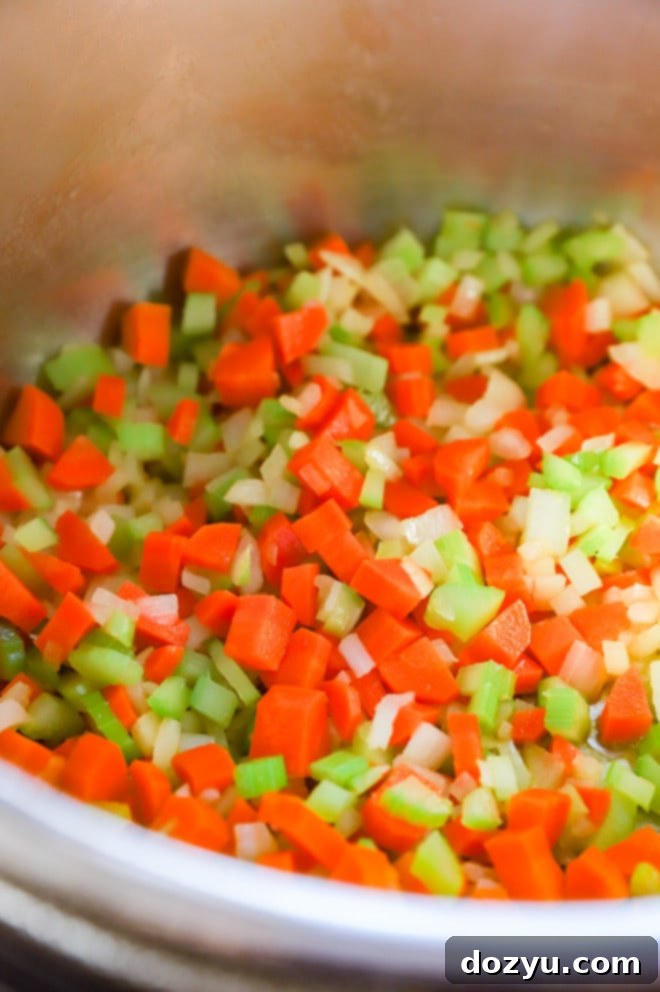
How to Prepare and Cook Mirepoix Step-by-Step
Creating a perfect mirepoix is straightforward when you follow these simple steps:
Prepare the Vegetables
Begin by thoroughly preparing your vegetables. For the carrots, peel them to remove the outer skin, which can sometimes be bitter or tough. For the celery, trim off both the root ends and any leafy tops, then rinse and scrub the stalks meticulously to ensure all dirt and grit are removed. Finally, peel the outer layers of the onion and trim its ends. This initial preparation is crucial for a clean, flavorful base.
Chop for Success
Precision in chopping is key for even cooking and optimal flavor release. Dice (chop) the prepared vegetables into roughly 1/2-inch pieces. This size is considered standard for most applications, such as soups, stews, and sautéed dishes, as it allows the vegetables to soften and release their aromatics without disintegrating too quickly. However, if your recipe calls for blending the mirepoix into a smooth sauce or a creamy soup, you can opt for slightly larger chunks, around 1-inch, as their texture will be pureed away anyway.
If your intention is to freeze the mirepoix for future use, this is the ideal moment to pause before cooking. It’s generally recommended to freeze the vegetables raw rather than cooked. Cooked onions and carrots, in particular, tend to become overly mushy and lose their desirable texture during the freezing and subsequent reheating processes. Freezing them raw preserves their integrity, allowing you to achieve the perfect texture and flavor when you finally cook them in your chosen dish.
Gentle Cooking
Now, it’s time to cook your mirepoix. Heat your chosen fat – either oil or butter – in a skillet or pot over medium-low heat. The key here is a gentle, consistent heat. Once the fat is hot and shimmering (if oil) or melted and slightly foaming (if butter), add the chopped vegetable mixture. Cook, stirring frequently and thoroughly, until the vegetables are beautifully softened and the onions turn translucent. This process typically takes about 10 to 12 minutes. It’s vital to monitor the heat carefully to ensure the vegetables do not brown or caramelize. If you notice any signs of browning, immediately reduce the heat. The goal is to gently sweat the vegetables, allowing them to release their aromatic compounds and natural sweetness, creating a subtle yet profound flavor base without any undesirable charred notes.
Expert Tips and Customizations
Achieving a perfect mirepoix every time involves a few essential techniques and offers opportunities for creative variations:
- Chop Everything Evenly: The importance of uniform dicing cannot be overstated. While you don’t need to be a Michelin-star chef, strive to chop all your vegetables into pieces of approximately the same size. This ensures that they cook evenly, releasing their flavors simultaneously and preventing some vegetables from becoming overcooked while others remain raw.
- Do Not Brown the Vegetables: This is a crucial distinction for mirepoix. Unlike caramelizing onions for a French onion soup, the goal here is to gently soften and “sweat” the vegetables. Browning indicates that sugars are caramelizing, which can impart a deeper, sweeter, sometimes slightly bitter flavor and a darker color that might not be desired for your final dish. Keep the heat on medium-low and reduce it immediately if you see any browning. Stir often to promote even cooking without color.
- Use the Right Size Pan: Overcrowding your pan is a common mistake that leads to steaming rather than sautéing. If your vegetables are too tightly packed, they will release moisture and boil instead of gently softening and developing flavor. This could mean you need to cook your mirepoix in two separate batches, especially if you’re making a larger quantity. Ensure all the vegetables have direct contact with the bottom of the pan to allow for proper and even cooking.
- Consider Your Fat: The fat you choose influences the final flavor. Butter adds richness and a golden hue, while olive oil offers a fruitier note. For a neutral flavor, canola or grapeseed oil work well.
- Add Aromatics: While the core three are essential, don’t shy away from adding other aromatics depending on your dish. A clove or two of minced garlic, a bay leaf, or sprigs of fresh thyme or rosemary can be added during the last few minutes of cooking the mirepoix to infuse even more depth.
Wondering what to make next? Here are some delicious recipes that shine with a mirepoix base: Instant Pot Chicken Stew | Tuscan White Bean Stew | Short Rib Ragu
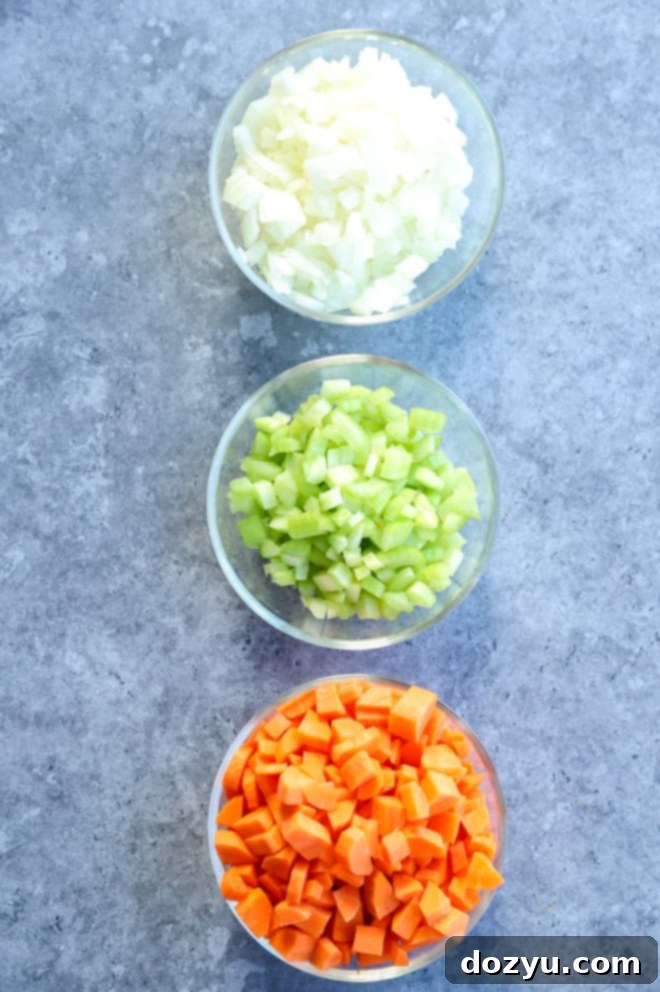
Celery Substitutions in Mirepoix
What if you find yourself without celery, or simply aren’t a fan of its distinct flavor? While celery is a classic component, you absolutely have options! A common and delicious substitute is to swap in green bell pepper. This adjustment transforms your mirepoix into “The Holy Trinity,” an iconic aromatic base most commonly used in vibrant Cajun and Creole recipes. The bell pepper provides a fresh, slightly bitter, and peppery note that creates a different, but equally compelling, flavor profile for your dishes. Other less common substitutes, depending on the dish, could include fennel (for an anise-like flavor) or even a bit of leek. However, green bell pepper remains the most traditional and effective direct substitute for celery in many savory contexts.
Freezing Mirepoix for Future Meals
Yes, absolutely, you can freeze mirepoix! This is one of the best kitchen hacks for efficient meal prep and a fantastic way to ensure you always have a flavor-packed base on hand. While it’s technically possible to cook a large batch and then freeze it, for optimal texture and versatility, I strongly recommend freezing the vegetables before cooking them. Cooked onions and celery tend to become quite mushy through the freezing and reheating process, which might not be ideal for dishes where texture matters. Freezing them raw preserves their crispness, allowing them to soften perfectly when cooked fresh in your recipes.
Freezing raw, chopped mirepoix is an incredible time-saver, especially when you’re looking to whip up a delicious soup, stew, or sauce on a busy weeknight. It eliminates the chopping step when you’re pressed for time, allowing you to dive straight into cooking.
However, if you happen to have leftover *cooked* mirepoix and don’t want it to go to waste, don’t despair! You can still freeze it. Cooked mirepoix is perfectly suited for use in blended recipes, where the textural element isn’t an issue. Think creamy butternut squash soup, velvety pumpkin and sweet potato soup, or any other puréed sauce. Simply cool it completely before freezing, and it will contribute wonderful depth of flavor to your blended creations.
Can I Double This Mirepoix Recipe?
Absolutely, you can easily make a double, or even triple, batch of this mirepoix recipe! Scaling up is a smart strategy for meal prepping and ensures you always have this essential base ready. The most important consideration when making a larger quantity is to ensure you have a skillet or pot that is sufficiently large. Remember the tip about not overcrowding the pan: if your pan is too small for a double batch, the vegetables will steam rather than sauté, resulting in a less flavorful and softer mirepoix. If necessary, cook your mirepoix in two separate batches to give the vegetables enough space to cook properly and develop their full aromatic potential. This ensures consistent quality across all batches.
Adding Other Vegetables to Your Mirepoix
While the classic trinity of onion, carrot, and celery forms the bedrock of traditional mirepoix, culinary creativity knows no bounds! You can certainly enhance the depth and complexity of your mirepoix by incorporating other aromatic vegetables. Experimentation is encouraged to tailor the base to your specific dish or personal preference. Consider trying additions like:
- Shallots: As mentioned before, they offer a milder, sweeter, and more delicate onion flavor.
- Leeks: These provide a subtle oniony sweetness, particularly the white and light green parts.
- Fennel: Adds a unique, slightly anise-like flavor that can be delightful in certain preparations, especially fish or pork dishes.
- Garlic: A universal aromatic that can be added towards the end of the cooking process to prevent burning, offering pungent depth.
- Bell Peppers: As seen in the Holy Trinity, bell peppers bring a fresh, slightly sweet or tangy note, depending on their color.
- Mushrooms: While not a traditional aromatic, finely diced mushrooms can add an earthy, umami depth when sautéed with the mirepoix.
These additions can significantly enhance the flavor profile, allowing you to customize your mirepoix for specific cuisines or dishes. Don’t be afraid to experiment and discover your favorite combinations!
Need some fresh inspiration for dinner this week? Dive into my extensive dinner recipes page for exciting ideas!
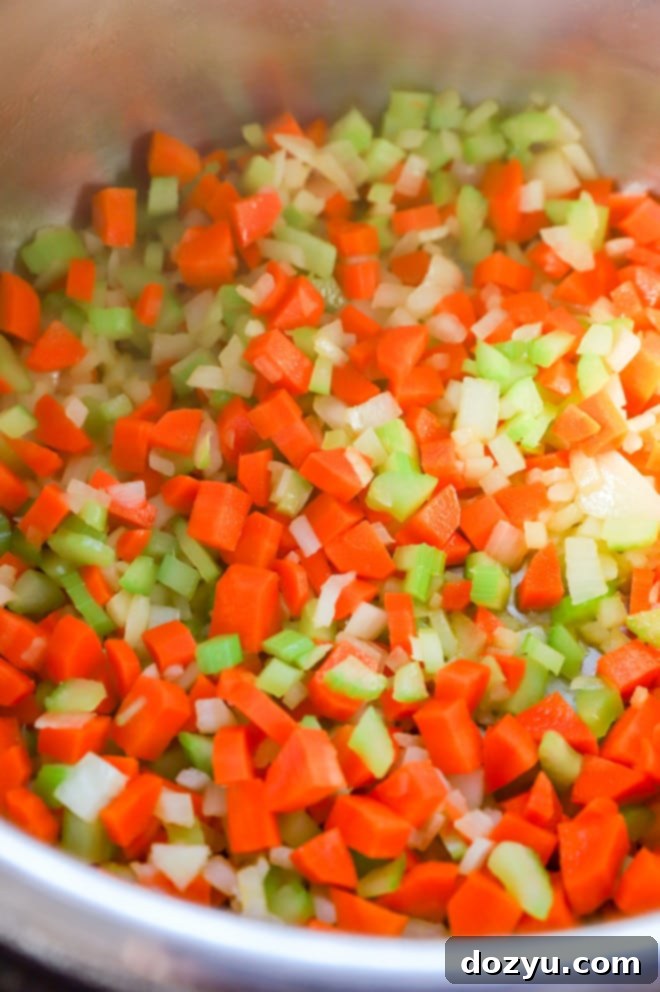
Creative Ways to Use Your Mirepoix
Once you’ve mastered making mirepoix, you’ll find it indispensable for elevating the flavor of countless dishes. It’s truly the starting point for so many culinary masterpieces. So, what are some of our favorite recipes that truly highlight the magic of a good mirepoix? So glad you asked!
- Hearty Soups and Stews: Mirepoix is the quintessential base for almost any soup or stew. For those who crave comforting and nourishing meals, our Tuscan White Bean Stew is a wildly popular recipe on the site, brimming with rich flavors and healthy, hearty ingredients like cannellini beans and fresh kale. Similarly, an Instant Pot Chicken Stew benefits immensely from the aromatic foundation of mirepoix, creating a deeply satisfying meal with minimal effort.
- Rich Ragus and Sauces: Mirepoix forms the backbone of many slow-cooked meat sauces. Our Instant Pot Short Rib Ragu is incredibly simple to prepare, yet the complex flavors it builds while cooking under pressure, starting with a robust mirepoix, are simply unmatched. It’s perfect for tossing with pasta or serving over polenta.
- Flavorful Risottos: Elevate your side dishes by incorporating mirepoix. Use it as the flavorful base for a roasted vegetable risotto to really round out the savory and sweet notes of the dish, adding a layer of depth that pre-cooked grains alone cannot provide.
- Braising Meats: Whether it’s beef, lamb, or chicken, starting your braising liquid with a sautéed mirepoix ensures a moist, tender, and incredibly flavorful result.
- Stuffings and Dressings: For holiday meals, a well-made mirepoix is crucial for moist and flavorful stuffings or savory bread puddings.
- Omelets and Frittatas: Sautéed mirepoix can be a surprisingly delicious addition to morning eggs, adding vegetables and flavor to your breakfast or brunch.
These are just a few ideas to get you started, but the possibilities are truly endless once you understand the foundational power of this simple yet profound vegetable base.
Storage and Reheating Instructions
Proper storage of mirepoix ensures its freshness and extends its usability, whether cooked or raw.
Store Cooked Mirepoix. After cooking, allow the mirepoix to cool completely to room temperature before transferring it to an airtight container. Store it in the refrigerator, where it will maintain its quality for approximately 2 to 3 days. This makes it perfect for short-term meal prep.
Reheat Cooked Mirepoix. To reheat, simply add the desired amount of cooked mirepoix to a skillet or pot over medium-low to medium heat. Stir occasionally until it is thoroughly warmed through. If it seems a little dry, you can add a small splash of broth or water.
Freeze Raw Mirepoix. For long-term storage and maximum versatility, freezing mirepoix before cooking is highly recommended. This method helps the vegetables retain their optimal texture, ensuring they cook perfectly in your future recipes. To freeze, simply add the chopped, raw vegetables to an airtight freezer-safe container or a resealable freezer bag. Press out as much air as possible before sealing to prevent freezer burn. Label with the date. Frozen raw mirepoix can be stored for up to 6 months, making it an excellent component for extended meal planning.
Freeze Cooked Mirepoix. If you have leftover cooked mirepoix, you can still freeze it, particularly if you plan to use it in blended soups or sauces where texture is less of a concern. Allow it to cool completely before transferring to a resealable bag or freezer-safe airtight container. Freeze for up to 3 months.
Thaw Frozen Mirepoix. To thaw frozen mirepoix (raw or cooked), transfer it to the refrigerator and let it thaw overnight. Once thawed, you can either reheat it as instructed above or use it directly in your recipe as desired. If using raw, you can often add it directly to a hot pan from frozen, adjusting cooking time slightly.
Finally, if you make this versatile mirepoix recipe, please be sure to give this recipe a star rating on the recipe card below and/or leave a comment! Your feedback is incredibly valuable, and I genuinely love hearing when you all create these recipes in your own kitchens. I make an effort to respond to every single comment.
Feel free to drop any questions below as well; I’m happy to help!
Oh, and be sure to tag me on Instagram if you share a photo of your mirepoix or the delicious dish you made with it! Seeing these recipes come to life in your homes is truly my favorite thing, and I love looking through all those wonderful photos. It honestly means the world to me!
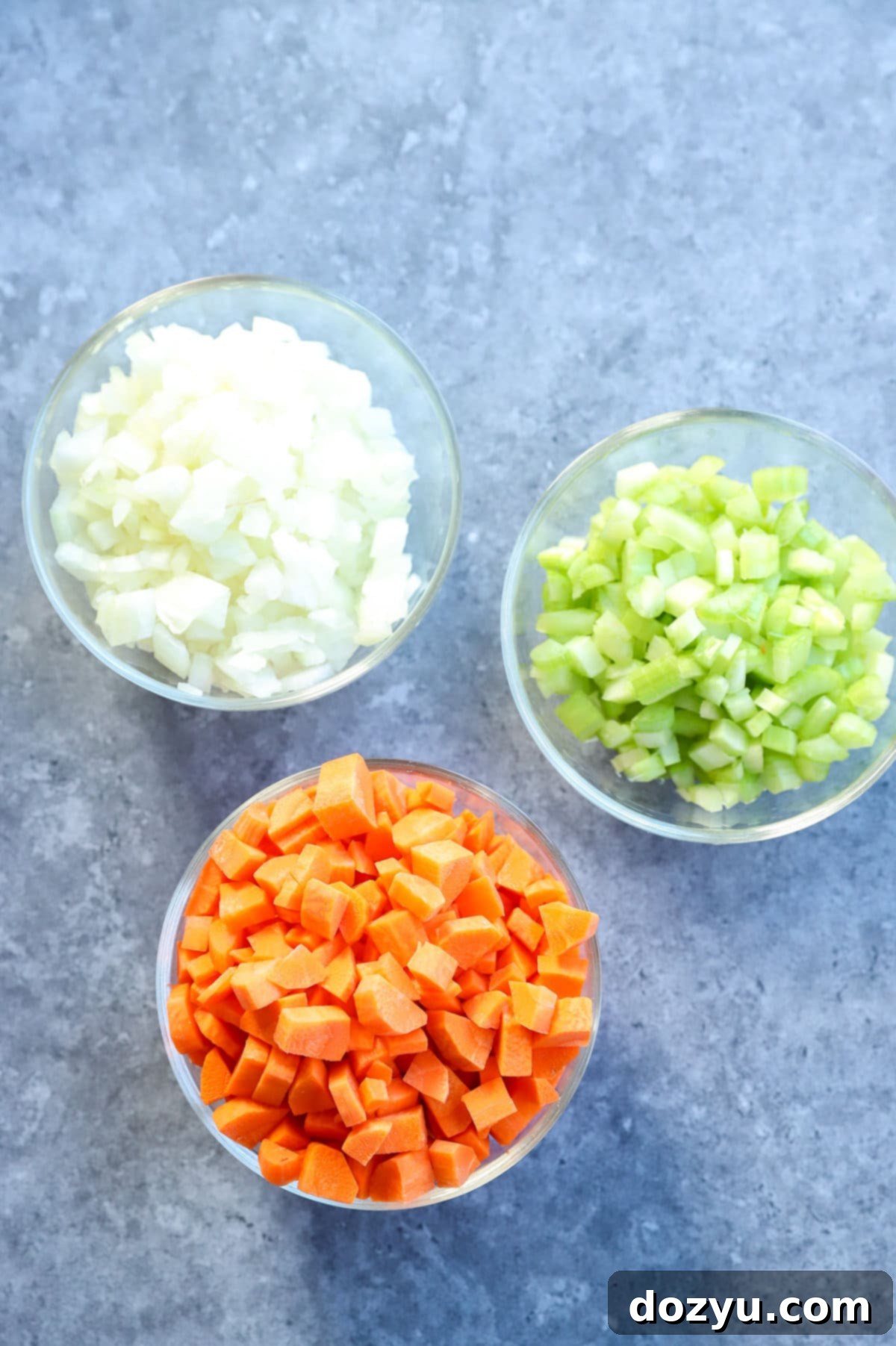
Mirepoix Recipe Card
Equipment
-
High-Quality Chef’s Knife
-
Sturdy Cutting Board (e.g., Organic Bamboo)
-
Large Skillet or Nonstick Pan
-
Dutch Oven (Optional, for larger batches or stews)
Ingredients
- 2 cups yellow or white onions peeled and diced into 1/2-inch pieces
- 1 cup celery trimmed, thoroughly cleaned, and diced into 1/2-inch pieces
- 1 cup carrots peeled and diced into 1/2-inch pieces
- 1 Tbsp olive oil or unsalted butter or your preferred cooking fat
Instructions
-
Heat the olive oil or butter in a large skillet or pot over medium-low heat. Allow the fat to melt (if butter) or shimmer (if oil).
-
Once the pan is hot, add the evenly chopped onion, celery, and carrot mixture. Cook, stirring frequently, until the vegetables have softened considerably and the onions have become translucent. This process typically takes about 10 to 12 minutes. Be vigilant to ensure the vegetables do not brown or caramelize; reduce the heat immediately if you notice any signs of browning. The key is to gently sweat them to release their aromatic flavors without adding color.
